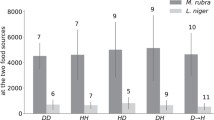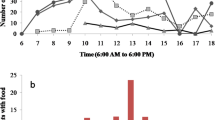Summary
An investigation of field foraging in colonies ofNeoponera apicalis is reported. We observed that workers develope an individualized foraging strategy with a high degree of regional specialization that persists for extended periods. The use of visual cues seems to constitute the basis for the spatial orientation. No recruitment was never observed during foraging as in other Ponerine ants, tandem running was only seen during a natural translocation of a colony. These observations reveal a primitive and original food-supply strategy in ants.
Resume
Trois colonies deNeoponera apicalis ont été observées lors d'une étude en nature. Dans cette espèce, chaque ouvrière pourvoyeuse prospecte et chasse solitaïrement dans un site individualisé pour lequel elle se spécialise sur de longues périodes. L'orientation des fourrageuses semble probablement reposer sur l'utilisation d'un repérage visuel. Durant le fourragement, il n'est jamais fait usage de processus de recrutement comme on l'observe chez d'autres Ponérines. Le «tandem running» a été observé seulement lors du déménagement spontané d'une colonie. Ceci révèle, à notre avis, une stratégie d'approvisionnement originale et primitive chez les fourmis.
Similar content being viewed by others
References
Agbogba C., 1981. — L'approvisionnement en proies chez quelques espèces de fourmis.Bull. Int. sct. Fr. U.I.E.I.S. Toulouse, 18–22.
Brown W.L. Jr., 1973. — A comparison of the Hylean and Congo West-African rain forest ant fauna. In «Tropical forest ecosystems in Africa and South-America: a comparative review.»,B.J. Meggers, E.S. Ayensu, W.D. Duckworth eds., Smithsonian Institution Press, Washington, pp. 161–185.
Cherix D., Rosengren R., 1980. — Estimation de la fidélité sur pistes et de l'âge des fourrageuses chezFormica lugubris Zett. dans le Jura suisse, par la méthode de coloration au spray.Bull. Int. sct. Fr. U.I.E.I.S., Lausanne, 61–69.
Duelli P., Duelli-Klein R., 1976. — Field studies in the navigation of South American ants (Hym., Formicidae: Ponerinae, Dolichoderinae, Formicinae).Stud. Entomol., 19, 409–419.
Fresneau D, Charpin A., 1977. — Une solution photographique au problème du marquage individuel des petits insectes.Ann. Soc. Entomol. Fr., 13, 1–5.
Fresneau D., Dupuy P. — A study of polyethism in a ponerine antNeoponera apicalis (Hym. Formicidæ).Anim. Behav., 10 p. (in press).
Hölldobler B., 1976. — Recruitment behavior, home range orientation and territoriality in harvester antsPogonomyrmex.Behav. Ecol. Sociobiol., 1, 3–44.
Hölldobler B., 1980. — Canopy orientation: a new kind of orientation in ants.Science, 210, 86–88.
Hölldobler B., Lumsden C.J., 1980. — Territorial strategies in ants.Science, 210, 732–739.
Hölldobler B., Moglich M., 1980. — The foraging system ofPheidole militicida (Hymenoptera: Formicidae).Insect. Soc., 27, (3), 237–264.
Hölldobler B., Traniello J., 1980. — Tandem running pheromone in ponerine ants.Naturwiss., 67, 360.
Levieux J., 1977. — La nutrition des fourmis tropicales. V. Eléments de synthèse. Les modes d'exploitation de la biocénose.Insect. Soc., 24, 235–260.
Maschwitz U., Hölldobler B., Moglich M., 1974. — Tandemalufen als Rekrutierumgsverhalten beiBothroponera tesserinoda Forel (Formicidæ: Ponerinæ).Z. Tierpsychol., 35, 113–123.
Rosengren R., 1971. — Route fidelity, visual memory and recruitment behaviour in foraging wood ants of the genusFormica (Hym., Formicidæ).Act. Zool, Fenn., 133, 1–106.
Rosengren R., 1977 a. — Foraging strategy of wood ants (Formica rufa group). I. Age polyethism and topographic traditions.Act. Zool. Fenn., 149, 1–30.
Rosengren R., 1977 b. — Foraging strategy of wood ants (Formica rufa group). II. Nocturnal orientation and diel periodicity.Acta. Zool. Fenn., 150, 1–30.
Wilson E.O., 1962. — Chemical communication among workers of the fire antSolenopsis sœvissima (Fr. Smith). 1. The organization of mass-foraging; 2. An information analysis of the odor trail; 3. The experimental induction of social response.Anim. Behav., 10, 134–164.
Author information
Authors and Affiliations
Rights and permissions
About this article
Cite this article
Fresneau, D. Individual foraging and path fidelity in a ponerine ant. Ins. Soc 32, 109–116 (1985). https://doi.org/10.1007/BF02224226
Received:
Accepted:
Issue Date:
DOI: https://doi.org/10.1007/BF02224226




